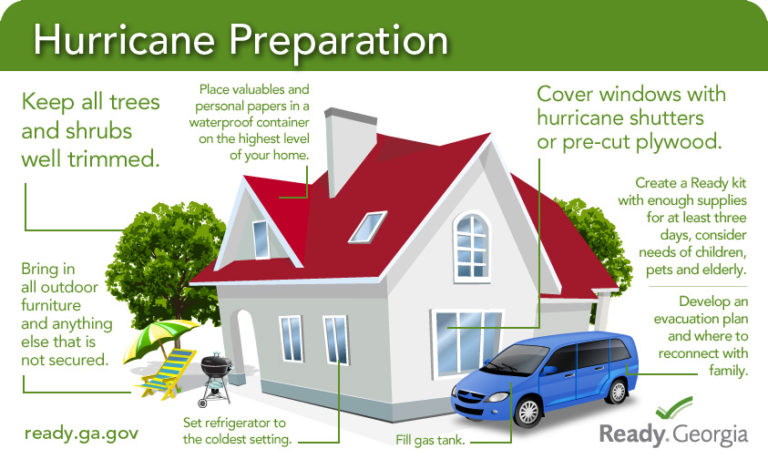Hurricane Harvey’s journey through the Gulf Coast of Texas and Louisiana is a jolting reminder of the importance of preparing your home and family for the natural disasters that commonly occur in the Low Country this time of year through December 1.
The Savannah community has outstanding resources at both the state level and the local level to give guidance on preparing for hurricanes. Per the State of Georgia’s website http://ready.ga.gov/be-informed/hurricanes/ every resident needs to understand their risks and should plan what to do in the event of an evacuation. Specifically for your home.
- Prepare to secure your property.
- Cover all of your home’s windows with hurricane shutters to protect them from high winds. Another option is to board up windows with 5/8” exterior grade or marine pre-cut plywood. Tape does not prevent windows from breaking.
- Plan to bring in all outdoor furniture, decorations, garbage cans and anything else that is not tied down.
- Keep all trees and shrubs well trimmed to make them more wind-resistent.
- Plan ahead for your pets. Shelters cannot accept pets due to health reasons, so it’s important to find a pet-friendly hotel or make arrangements with family or friends in advance.
- Know your area’s flood risk – if unsure, call your local emergency management agency or planning and zoning department, or visit www.floodsmart.gov.
- Property insurance does not typically cover flood damage. Talk to your insurance provider about your policy and consider if you need additional coverage. The National Flood Insurance Program is designed to provide reasonable flood insurance in exchange for the careful management of flood-prone areas by local communities. The program, administered by FEMA, is available in hundreds of participating Georgia communities.

FIVE GALLON EMERGENCY KIT CHECKLIST from Chatham Emergency Management Agency (CEMA)
Building your five gallon emergency kit can save you money and help you survive a disaster! It’s easy, but it can also be fun and educational if you include the whole family.


- bar soap
- tissues
- floss
- baby shampoo
- hand lotion
- sunscreen
- toothpaste
- toothbrushes
- feminine hygiene pads
- comb
- toilet paper
- wash cloths
- basic first-aid guide
- moist towelettes
- antiseptic towelettes
- latex gloves
- acetaminophen (Tylenol)
- ibuprofen (Advil)
- aspirin
- diphenhydramine (Benadryl)
- loperamide (ImodiumA-D)
- burn cream
- sting relief towelettes
- hydrocortisone cream
- triple antibiotic ointment (Neosporin)
- cough drops
- earplugs
- instant ice pack
- tweezers
- nail clippers
- scissors
- digital thermometer
- cotton balls
- waterproof adhesive
- gauze rolls
- gauze pads
- moleskin
- band-aids
- butterfly bandages
- ace bandage
- triangular bandage
- collar
- leash
- medical and vaccination
- records
- extra food and water
- glow sticks (12 hrs)
- flashlight
- liquid candle
- matches
- mylar blankets
- hand warmers
- AM/FM radio
- whistle and lanyard
- sewing kit
- blank notebook
- pencils
- batteries (for flashlight and radio)
- zip ties
- P-38 can opener
- trash bags
- N95 dust masks
- duct tape
- small tarp
- paracord
- safety goggles
- work gloves
- It may be beneficial to store food with your emergency kit so that if you need to evacuate, or you need to shelter in place, you will have food to sustain you and your family.
- If you do not regularly eat canned chicken or freeze dried ice cream, don’t put it in your emergency kit. Try to include non-perishable foods that you and your family eat on a regular basis. Trying to introduce your children to new foods in the middle of an already stressful event may be difficult.




